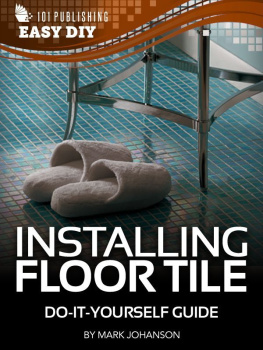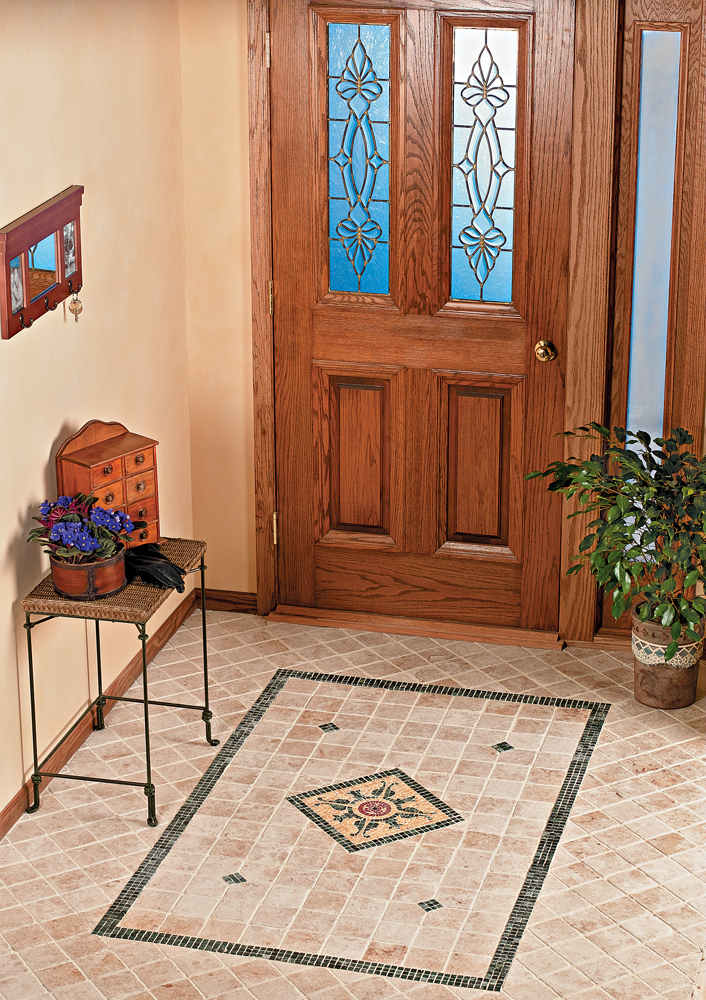INSTALLING FLOOR TILE:
DO-IT-YOURSELF GUIDE
ERIC SMITH

Contents
Introduction
Building materials evolve and change very quickly in the do-it-yourself world. New formulations, advanced installation systems, and a host of plug-and-play gimmicks make keeping pace with the things we put into our houses a constant battle. But ceramic tile is different. Although trends, colors, and shapes may look slightly different from year to year, tiling is a lifelong skill that will serve you well as long as you own your home. Laying tile is a very popular DIY project for a number of reasons, but the primary appeal is that tile is a manageable material that yields beautiful, long-lasting floors for a relatively small investment. Because of the nature of the material and the installation process, you can work at your own pace. If you make an error, it is not difficult to back up and re-do the work.
Here is information that shows you, step-by-step, exactly how to work with tile. Layout, installing subbases, cutting and fitting, setting, grouting, and sealing are just some of the techniques you will learn.
A floor typically is one of the largest surfaces in a room and so plays a major role in establishing the style of the space. Neutral or dramatic, plain or elaborate, these projects present the techniques necessary for just about any design you can find or dream up.
Floor Tiling Tools & Materials
Floor tile needs to be more than just attractiveit needs to be strong and durable as well. After all, floors bear the weight of furniture, foot traffic, and the sudden impact of every one and every thing that falls on them. Floor tile is engineered to tolerate these stresses.
When shopping for tile, look for ratings by the American National Standards Institute (ANSI) or the Porcelain Enamel Institute (PEI). If ratings arent available, check with your dealer to make sure the tile youre considering is suitable for your project. Before you start shopping, consider where the tile will be used and what you want it to accomplish. Will it be exposed to moisture? Should it be a focal point or a subtle background? Do you want the floor to establish the rooms color scheme or blend into it? The range of options is truly mind-boggling, so establish some guidelines before you go shopping to simplify the selection process.
Floor Tile Ratings
Floor tiles are thicker and almost always larger than wall tiles. Ceramic floor tiles are usually between 1/4 and 1/2" thick. Floor tile often comes labeled with water absorption and Porcelain Enamel Institute ratings. Ratings indicate how a tile can be used and whether or not it needs to be sealed against moisture. Absorption is a concern because tile that soaks up water is susceptible to mildew and mold and can be difficult to clean. Tile is rated non-vitreous, semi-vitreous, vitreous, or impervious, in increasing order of water resistance. Non-vitreous tile is quite porous; semi-vitreous is used in dry-to-occasionally-wet locations; vitreous tile can be used without regard to its exposure to moisture. Impervious tile is generally reserved for restaurants, hospitals, and commercial applications where sanitation is a special concern.
The PEI number is a wear rating that indicates how the tile should be used. Ratings of 1 and 2 indicate tile is suitable for walls only; tile rated 3 and 4 is suitable for all residential applicationswalls, counters, and floors. Most tile carries absorption and PEI ratings, but some, especially imported and art tiles, may not. Ask the retailer if youre not sure.
Depending on the retailer, tile may also have other ratings. Some tile is graded 1 to 3 for the quality of manufacturing. Grade 1 indicates standard grade; 2 indicates minor glaze and size flaws; 3 indicates major flaws; use for decoration only. Tile suitable for outdoor use is sometimes rated with regard to its resistance to frost. Finally, coefficient of friction numbers may be included with some tile. The higher the coefficient, the more slip resistant the tile. A dry coefficient of .6 is the minimum standard established by the Americans with Disabilities Act.
Types of Tile
Porcelain tile is produced by pressing refined clay into shape and then firing it in a kiln at very high temperatures. The resulting tile is extremely hard, absorbs very little or no water, and doesnt stain or mildew. Porcelain tile is manufactured in all shapes and sizes, and, because its white base color accepts dye beautifully, a virtually unlimited range of colors and finishes are available. Tile makers can also imprint textures when the tile is pressed to create a slip-resistant surface well suited for floors in wet locations. Porcelain tile is colored by mixing dye into the clay rather than applying it in a glaze, which means the color extends through the full thickness of the tile. Because of this process, tile makers can press finer, more intricate textures and patterns into the tile. Porcelain tile can even be pressed so that its nearly indistinguishable from cut stone, which tends to be more expensive but less durable. For ease of care, porcelain is hard to beat. Its smooth finish and imperviousness to moisture keep soil and stains from setting in, making it easy to maintain.
Glazed ceramic tile is made from clay pressed into a shape by a machine, glazed, and then fired in a kiln. The glaze, made up of a number of glass and metal elements, provides color and creates a hard, shiny surface. To make floor tile slip-resistant, the surface can be textured, given a slightly raised design, or the glaze itself may include materials added to create a non-skid surface. Glazed tile generally absorbs very little or no water, making it both easy to maintain and mildew resistant. If the glaze is hard and scratch-resistant and the tile is properly installed and maintained, glazed ceramic tile can last for decades.
Glass tile is an especially interesting option for walls, although in some applications it can be used on floors as well. It is available in a variety of colors, degrees of translucency, shapes, and sizes. Because most glass tile is translucent to some degree, its important to use a white tile adhesive that wont affect the appearance of the tiles once they are installed. Glass is impervious to moisture, but can be scratched and cracked, so it shouldnt be installed where it will get hit by swinging doors or scratched by general traffic.
Natural stone tile is marble, granite, slate, and other more exotic stones cut very precisely into tiles of various sizes that can be installed just like manufactured tile. Because stone is a natural material, variations in color, texture, and markings must be expected. Manufacturers do offer stone tiles with some added finish. In addition to polished tile, suppliers offer a variety of distressed and textured finishes that can be very attractive as well as slip-resistant. With the exception of granite, natural stone tends to be quite porous and requires periodic sealing to prevent staining. Also, not all types are uniformly abrasion-resistant, so check before making a purchase. Some stone is so soft that it can be very easily scratched by normal use.
TIP: Grout can stain porous material, so take great care in grouting and be sure to follow manufacturer instructions.
Mosaic tiles are ceramic, porcelain, terra-cotta, stone, or other tile cut into small pieces. Individual small tiles are often mounted on a mesh backing so that large squares of many tiles can be installed at once. These squares may be a solid color or contain a pattern or image. Individual mosaic tiles are also available for making custom accents and mosaics. Mosaic tile can be very low maintenance or it can require periodic application of sealant, depending on the material. Mosaic tile is generally quite slip-resistant because of the large number of grout lines in an installation.








